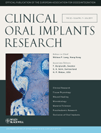Improved pre-osteoblast response and mechanical compatibility of ultrafine-grained Ti–13Nb–13Zr alloy
Abstract
Objective: Metallic implantation materials having high yield strength, low elastic modulus, and non-cytotoxic alloying elements would be advantageous for the long-term stability of implants. This study assessed the surface and mechanical properties, and also in vitro osteoconductivity of ultrafine-grained (UFG) Ti–13Nb–13Zr alloy produced by dynamic globularization without any severe deformation for future biomedical applications as an endosseous implant material.
Material and methods: The surface characteristics and mechanical properties were investigated by orientation image microscopy, contact angle measurements, optical profilometry, and uniaxial tension tests. Mouse calvaria-derived pre-osteoblastic cell (MC3T3-E1) attachment, spreading, viability, alkaline phosphatase (ALP) activity, and quantitative analysis of osteoblastic gene expression on UFG Ti–13Nb–13Zr alloy were compared with coarse-grained (CG) Ti–13Nb–13Zr and CG Ti–6Al–4V alloys.
Results: Dynamic globularized Ti–13Nb–13Zr alloy has an ultrafine grain size (0.3 μm) and an excellent combination of yield strength and elastic modulus compared with CG alloys, which displayed significantly lower water contact angles compared with CG alloys (P<0.05). The UFG and CG Ti–13Nb–13Zr alloys displayed significantly increased cellular attachment compared with CG Ti–6Al–4V alloy (P<0.05). The UFG Ti–13Nb–13Zr supported better cell spreading and more numerous focal adhesions. ALP activity (P<0.05) and mRNA expressions of the osteoblast transcription factor genes (osterix, Runx2) and marker gene for osteoblast differentiation (osteocalcin) were markedly increased in cells grown on the UFG substrate compared with CG substrates at early incubation timepoints.
Conclusion: Enhanced pre-osteoblast response to UFG Ti–13Nb–13Zr substrate is attributable to the non-cytotoxic alloying elements and the submicron scale grain size contributes to the superior surface hydrophilicity and abundant grain boundaries favorable for cell behavior. These findings indicate that dynamic globularized UFG Ti–13Nb–13Zr alloy is promising for load-bearing endosseous implant material because of excellent mechanical and biological compatibilites.
To cite this article: Park CH, Lee CS, Kim Y-J, Jang J-H, Suh J-Y, Park J-W. Improved pre-osteoblast response and mechanical compatibility of ultrafine-grained Ti–13Nb–13Zr alloy.Clin. Oral Impl. Res. 22, 2011; 735–742doi: 10.1111/j.1600-0501.2010.02053.x




